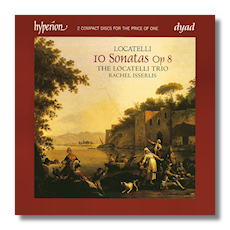
The Internet's Premier Classical Music Source
Related Links
- Locatelli Reviews
- Latest Reviews
- More Reviews
-
By Composer
-
Collections
DVD & Blu-ray
Books
Concert Reviews
Articles/Interviews
Software
Audio
Search Amazon
Recommended Links
Site News
 CD Review
CD Review
Pietro Antonio Locatelli
10 Sonatas Op. 8 (1744)

- Sonata for Violin & Continuo in F Major, Op. 8 #1
- Sonata for Violin & Continuo in D Major, Op. 8 #2
- Sonata for Violin & Continuo in G minor, Op. 8 #3
- Sonata for Violin & Continuo in C Major, Op. 8 #4
- Sonata for Violin & Continuo in G Major, Op. 8 #5
- Sonata for Violin & Continuo in E Flat Major, Op. 8 #6
- Trio Sonata for 2 Violins & Continuo in A Major, Op. 8 #7
- Trio Sonata for 2 Violins & Continuo in D Major, Op. 8 #8
- Trio Sonata for 2 Violins & Continuo in F minor, Op. 8 #9
- Trio Sonata for 2 Violins & Continuo in A Major, Op. 8 #10
Rachel Isserlis, violin
The Locatelli Trio
Hyperion CDD22057
Pietro Antonio Locatelli (1695-1764) was not part of the bevy of composers born in 1685 – by ten years. But he is a composer of significance, stature and accomplishment. Born in Bergamo in the north of Italy, he was first apprenticed in Rome at the time when Corelli's influence was at its greatest; then he moved to Amsterdam in 1729, where he published these ten sonatas (six violin sonatas with basso continuo and four trio sonatas), Opus 8 at his own expense in 1744.
The publication of Locatelli's Opus 8 was in fact the last in a series: in the previous dozen years, since 1732, he had issued seven volumes (Opp. 2 to 8), supervising the printing of the chamber works himself but engaging local professionals in the case of the concerti. There was an Opus 9 (it was announced by Covens in 1762); but it is has not survived. Assuming that no other works were produced, the sonatas on these two CDs effectively mark the end of Locatelli's career. In any case, they come last before a period of 18 years' silence, which is generally accepted as a mystery.
Even without these distinctions, the Opus 8 sonatas stand out for stylistic reasons: contemporary publishing conventions called usually for six or twelve pieces of the same genre. Here, though, there are ten… and mixed. It's possible that Locatelli was 'scooping up' previously unpublished works into this collection and felt their style to be sufficiently consistent to confer cohesion on the publication. It was just as likely (assuming that Locatelli did not just need the money!) that he was writing for the strengths and/or tastes of particular players in his ambit; these may or may not include the works' dedicatee, a local gunpowder merchant Abraham Croock. At any event we should conclude that Locatelli was a shrewd businessperson trying to turn some wonderful, inventive music to his advantage.
The sonatas have contrasting properties: some are obviously strongly influenced by Corelli… a four-movement structure, the first one slow. Others display more contemporary characteristics… three movements predominantly homophonic thus highlighting the lines of the solo instrument against the continuo. Since Locatelli was every bit as well-known as a performer before turning to composition, perhaps these were in part written for himself? The sonata da camera as developed in these works places less emphasis on the dance and fugato movements than would be the case with a traditional Corellian sonata da chiesa.
Even within the sonatas there is variety: of the six violin sonatas, four are three-movement and two are four-movement. The progression is from slow to fast, although Sonata VI ends with variations and elevates the virtuosity to new heights. The trio sonatas, on the other hand, were changing in purpose: they had become – by the time of the publication of Opus 8 – more of a showcase for composers and an opportunity for amateur trios to join together and play. Again the numbers and styles of movements across the four works varies, shows Locatelli's development and lends further evidence to the notion that Opus 8 was indeed a collection of works written across a number of years.
The sonatas come on these two CDs in the order of the six violin sonatas first, then the trio sonatas, numbers VII to X. Almost any way that they had been recorded, though, would have presented variety and the mixture of traditional, conservative styles with innovation, the virtuosity of the violin and the imagination of Locatelli. If this is a period which you enjoy, or wish to explore – the final developments of the Baroque era – Locatelli's Opus 8 should not be missed. The playing is expert, up to the extremely high standards to be expected from such people as Elizabeth Wallfisch (and Rachel Isserlis in the trio sonatas) violins; Richard Tunnicliffe cello; Pail Nicholson harpsichord. The recording, first released in 1994, is excellent, mellow and sonorous. The booklet illuminating and the two CDs excellent value for money. Almost as much to the point is the fact that this is the only recording of this set in the current catalog, which would make it desirable even if it were only played half as well (which is very well) as it is. Recommended without hesitation.
Copyright © 2007, Mark Sealey




















